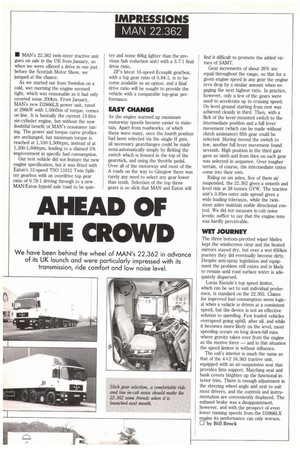AHEAD OF THE CROWD
Page 42

If you've noticed an error in this article please click here to report it so we can fix it.
We have been behind the wheel of MAN's 22.362 in advance of its UK launch and were particularly impressed with its transmission, ride comfort and low noise level.
• MAN's 22.362 twin-steer tractive unit goes on sale in the UK from January, so when we were offered a drive in one just before the Scottish Motor Show, we jumped at the chance.
As we started out from Swindon on a cold, wet morning the engine seemed tight, which was reasonable as it had only covered some 200Iun. From January, MAN's new D2866LX power unit, rated at 296kW with 1,500Nm of torque, comes on line. It is basically the current 12-litre six-cylinder engine, but without the now doubtful benefit of MAN's resonance tuning. The power and torque curve profiles are unchanged, but maximum torque is reached at 1,100-1,500rpm, instead of at 1,200-1,600rpm, leading to a claimed 5% improvement in specific fuel consumption.
Our test vehicle did not feature the new engine specification, but it was fitted with Eaton's 12-speed ISO 11612 Twin Splitter gearbox with an overdrive top gear ratio of 0.78:1 driving through to a new MAN/Eaton hypoid axle (said to be quie ter and some 60kg lighter than the previous hub reduction unit) with a 3.7:1 final drive ratio.
ZF's latest 16-speed Ecosplit gearbox, with a top gear ratio of 0.84:1, is to become available as an option, and a final drive ratio will be sought to provide the vehicle with a comparable top-gear performance.
EASY CHANGE
As the engine warmed up maximum motorway speeds became easier to maintain. Apart from roadworks, of which there were many, once the fourth position had been selected via the single H gate, all necessary gearchanges could be made semi-automatically simply by flicking the switch which is housed in the top of the gearstick, and using the throttle pedal. Over all of the motorway and most of the A roads on the way to Glasgow there was rarely any need to select any gear lower than tenth. Selection of the top three gears is so slick that MAN and Eaton will find it difficult to promote the added virtues of SAMT.
Gear increments of about 26% are equal throughout the range, so that for a given engine speed in any gear the engine revs drop by a similar amount when engaging the next highest ratio. In practice, however, only a few of the gears were used to accelerate up to cruising speed. On level ground starting from rest was achieved cleanly in third. Then, with a flick of the lever-mounted switch to the intermediate position and a full lever movement (which can be made without clutch assistance) fifth gear could be selected. Having moved the switch to low, another full lever movement found seventh. High position in the third gate gave us ninth and from then on each gear was selected in sequence. Over tougher terrain, of course, the intermediate ratios come into their own.
Riding on six axles, five of them air suspended, the 22.362 gives a smooth and level ride at 38 tonnes GVW. The tractive unit's 3.85m outer axle spread gives a wide loading tolerance, while the twinsteer axles maintain stable directional control. We did not measure in-cab noise levels: suffice to say that the engine note was hardly perceivable.
WET JOURNEY
The three bottom-pivotted wiper blades kept the windscreen clear and the heated mirrors stayed dry, but over a wet 650km journey they did eventually become dirty. Despite anti-spray legislation and equipment the problem still exists and is likely to remain until road surface water is adequately dispersed.
Lucas Kienzle's top speed limiter, which can be set to suit individual preference, is standard on the 22.362. Claims for improved fuel consumption seem logical when a vehicle is driven at a consistent speed, but the device is not an effective solution to speeding. Few loaded vehicles overspeed going uphill, after all, and while it becomes more likely on the level, most speeding occurs on long down-hill runs where gravity takes over from the engine as the motive force — and in this situation the speed limiter is without influence.
The cab's interior is much the same as that of the 4x2 16.363 tractive unit, equipped with an air-suspension seat that provides firm support. Matching seat and bunk covers brighten up the functional interior trim. There is enough adjustment in the steering wheel angle and seat to suit most drivers, and the controls and instrumentation are conveniently displayed. The exhaust brake was a disappointment, however, and with the prospect of even lower running speeds from the D2866LX engine its performance can only worsen. 0 by Bill Brock






















































































